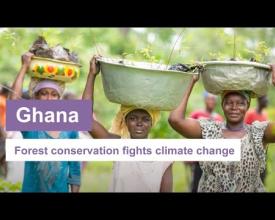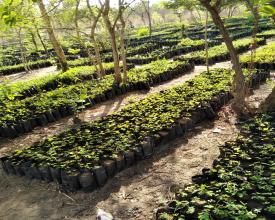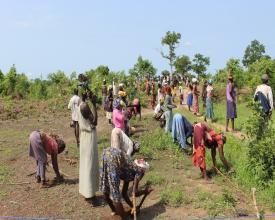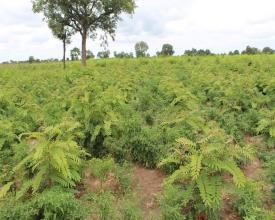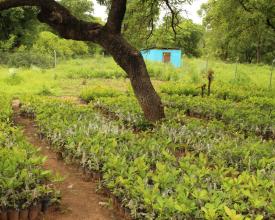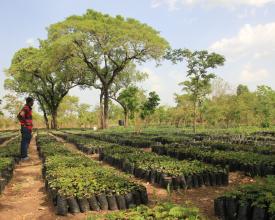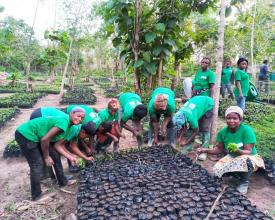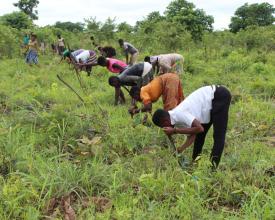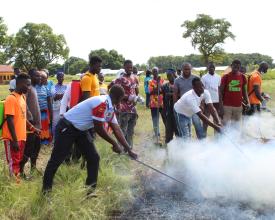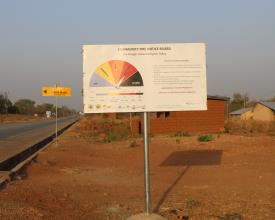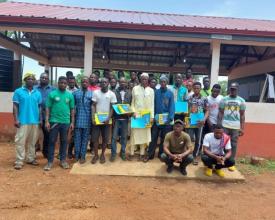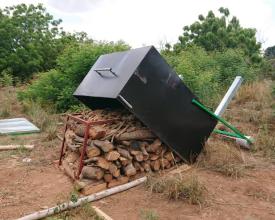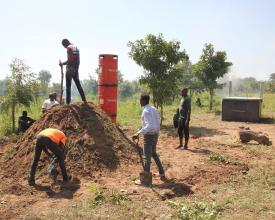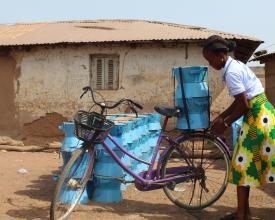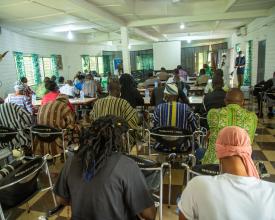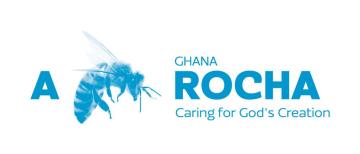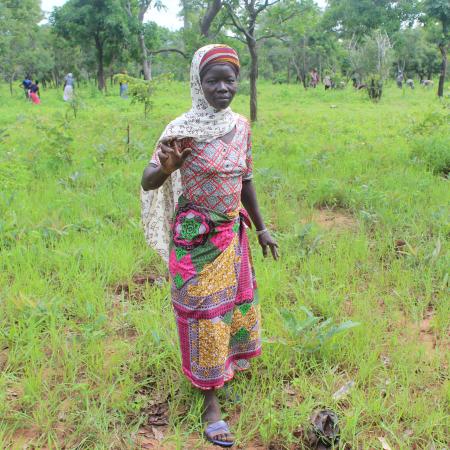
Forest Landscape Restoration through a Sustainable Wood Energy Value Chain
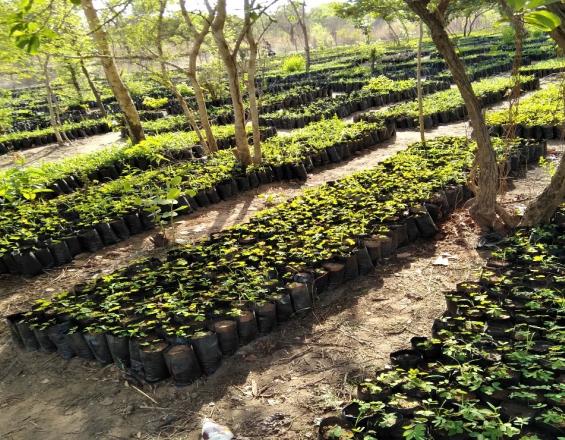
The “Forest Landscape Restoration through a Sustainable Wood Energy Value Chain” project, is implemented in the Bono East and Savannah Region of Ghana. Through the sustainable production and efficient use of energy wood, forests in selected regions in Ghana are being restored and preserved thus contributing to the implementation of the national climate policy and to the improvement of the framework conditions for sustainable forest management and energy supply in Ghana.
Wood energy in form of charcoal and fire wood is the main source for cooking in Ghana. More than 14 Mill. cbm of wood are used annually for the consumption as charcoal or fire wood. Wood energy is therefore one driver for forest degradation, especially in charcoal producing hotspots. This solution elaborates on supporting partner institutions and small farmers in establishing a sustainable wood energy value chain integrated in Forest Landscape Restoration measures.
Context
Challenges addressed
Biomass represents 39% of the energy consumption in Ghana. Firewood or charcoal is still the main fuel for 4.53 million households in 2021 (Ghana Statistical Service, 2022) and the demand for wood fuel continues to rise due to public growth. This growing demand has led to concerns over impacts on tree cover and the security of future supplies. The National Energy Policy (2010) asserts that “the exploitation of biomass for energy purposes results in deforestation” (Ministry of Energy, 2010) and the charcoal sector is specifically identified as a “major driver of deforestation” (Ministry of Energy, 2019).
The ownership and user rights for natural forest areas are often unclear and uncontrolled and illegal logging for charcoal production is threatening valuable and rare tree species. In addition emissions from smoke during production and consumption of charcoal can cause severe health effects.
Location
Process
Summary of the process
The four building blocks all constitute the implementation steps in the efficient and sustainable use of fuel wood to help reduce the pressures on forest.
Building Blocks
Increase woody biomass sources
The Forest Landscape Restoration project established 3 community tree nurseries in the project area and raised 1 million local tree seedlings from 2020-2022. Natural forests degraded by charcoal production, illegal logging, cattle grazing, bush fires etc. were rehabilitated and 315 ha were established with fast growing tree species to serve as wood source for charcoal production. Landowners and plantation owners were trained in ecosystem services of natural forests, forest and biodiversity monitoring, rehabilitation measures and agroforestry practices.
Activities are sustained in the long term and strengthened in their function as carbon sinks through management plans and monitoring systems for the rehabilitation of degraded natural forests and agroforest areas.
Enabling factors
Land availability, clear land use rights, and community commitment are key for establishing and sustainable management of energy wood and agroforestry sites. Especially in very degraded areas with low woody biomass sources fast growing tree species can provide short-term fuel wood for charcoal production.
Lesson learned
In areas with a good natural regeneration potential planting of trees is often not necessary. More important is the reduction of risks like uncontrolled bush fires which harm upcoming regeneration. Selected fast grwoing tree species need to be suitable to the site conditions and should be integrated in agroforestry systems or green fire belts as it reduces the risk of loss through bush fires or cattle grazing.
Sustainable management of forest resources
Logging of trees in natural forests for charcoal and fire-wood production is mostly unregulated and not monitored in Ghana. This leads to overexploitation and unsustainable forest management. The implementation of an inventory and monitoring system which based on communities’ needs is key to achieve sustainable forest management.
Enabling factors
Community forest management plans were developed which integrate the sustainable management of the project restoration and energy wood plantation sites, but also the protection of selected zones like e.g. river buffers and general management of the forest resources. Regular uncontrolled bushfires destroy upcoming natural regeneration and planted tree seedlings. A bush fire management system was therefore integrated in the plans as well and supported by the training of fire volunteers in patrolling and suppression of uncontrolled fires
Lesson learned
Communities and charcoal producers need to be well integrated in the development of a forest monitoring and management system. Beside that it needs to be supported by the local authorities to determine, for example the sustainable volume of wood which can be annually harvested and to select zones and tree species which should be protected from logging. For a functionable bush fire management it is key that especially farmers and herdsman are aware about the risks and damages uncontrolled fires can cause and how they can control them.
Reduce demand on wood energy
Two approaches to the energy-efficient use of wood energy have been introduced in the project communities. 5000 efficient charcoal cookstoves and 5 mobile charcoal kilns (Adam box kiln) have been distributed for improved charcoal production and consumption. The box kiln has been proven to have an efficiency of 30% compared to traditional kilns and is easier and cheaper to construct than conventional metal kilns. The local communities have been trained in the operation of the metal box kiln. In addition, training of trainers was conducted to introduce other more efficient ways of charcoal production like e.g. the Casamance technique.
Enabling factors
The majority of the charcoal producers in Ghana are using the earth mound technique to produce charcoal with low efficiency of mostly below 20%. With improved techniques, efficiencies can be improved by up to 35% which can half the demand for wood for producing the same amount of charcoal. In addition, carbonisation is done in fewer days and needs less work labour.
Lesson learned
Charcoal producers welcomed the box kiln due to the faster carbonization, higher efficiency and less work (e.g. no digging of soil). As the charcoal producers work mainly individual it is important to establish producer groups so the kiln can be used continually. As the charcoal production normally takes place where the trees are logged, it is also important to arrange a transportation system for the box kiln or use it beside the established energy wood plantations where higher amounts of biomass are available.
Support government strategies for a sustainable wood energy value chain
To shift from unsustainable to sustainably produced charcoal and alternative fuels (e.g. briquets from agricultural residues) they need to be competitive in the market. This can only be achieved with government support by regulating charcoal production and enabling competitive prices. These include the setting up of a formal sector and a sustainable forest management system (see building block 2).
Enabling factors
The government of Ghana sees the need of reducing forest degradation through charcoal production and has set ambitious policy actions in the updated NDCs to achieve efficient and sustainable charcoal production. The government is also working on a national regulation for the production of charcoal and has included further measures like the promotion of efficient cookstoves and the establishment of woodlots in different strategies.
Lesson learned
In the development of regulations and strategies for sustainable charcoal production, it is important to include the different stakeholders, especially the local communities and charcoal producers. They need to see the benefits of a formalized sector and regulation system and need to be supported to adapt to it. Besides that, it is important to develop alternative income sources to achieve the promotion of alternative fuels and a reduction of charcoal production.
Impacts
- 315 ha of degraded lands have been afforested with fast growing tree species and will be used sustainably for the supply of energy wood
- 480 ha of degraded natural forest are under restoration measures like FMNR and enrichment planting and sustainable management plans have been developed
- 264 ha of agroforestry systems with Cashew, Mango, Moringa, Dawadawa and other local species have been established with 150 smallholder farmers
- Over 3000 persons (80% women) in the project communities were engaged in the raising, planting and maintenance of more than 1 million seedlings
- 170 community persons were selected and trained and equipped as fire volunteers, for bush fire prevention, pre-suppression and suppression
- Fire Danger Rating Index sign boards have been installed in all 12 project communities and are daily updated based on three installed weather stations
- 5000 improved cookstoves have been distributed in project communities to reduce the consumption of charcoal
- 5 metal kilns (Adam-Box) have been constructed and distributed to support the efficient carbonization of charcoal.
- By supporting the Ministry of Energy, a new NDC policy action on promoting sustainable charcoal production was integrated in the updated NDCs of Ghana.
- Charcoal value chain studies have been conducted in Senegal and Burkina Faso and recommendations for a sustainable wood energy value chain in the ECOWAS region been developed.
Beneficiaries
- Government officials
- Selected project communities
- Landowners
- Local leaders
- Charcoal producers
Sustainable Development Goals
Story

Karima is a 42-year-old woman with 5 children living in Soalepe, a small town in the Savannah region of Ghana. She burns and sells charcoal as a family business for her living and has been a charcoal producer since her childhood. As a result of the constant cutting of trees around her vicinity for the production of charcoal, she now has to walk long distances in search of wood for charcoal production. This has increased her time and costs for the transportation of the charcoal from the forest to her house.
The introduction of the Forest Landscape Restoration project in her community has positively impacted her charcoal business. She has had the opportunity to plant fast growing trees on the degraded lands around her vicinity in a form of a woodlot. In the next 2 to 3 years, she would not have to walk long distances in search of wood for her charcoal business as she can access directly the woodlots. The FLR project also introduced to her the efficient ADAM Box kiln for the carbonization of charcoal. In combination with the woodlot, she can now harvest and produce charcoal at one place and by using the box kiln she doesn’t need to cut grass and dig soil onto the packed wood before burning, which is the traditional way for charcoal production. With all the effort in the processes of burning charcoal the traditional way, it takes her more than one week to finish one complete carbonization with a very low efficiency. With the box kiln, she can produce within 3 days high-quality charcoal ready for the market, and more efficient as compared to the traditional way of carbonizing charcoal.
Karina is now an advocate for forest landscape restoration and influencing other charcoal producers, to engage in the restoration of degraded lands around their vicinity by planting more trees for the sustainability of their charcoal business.
